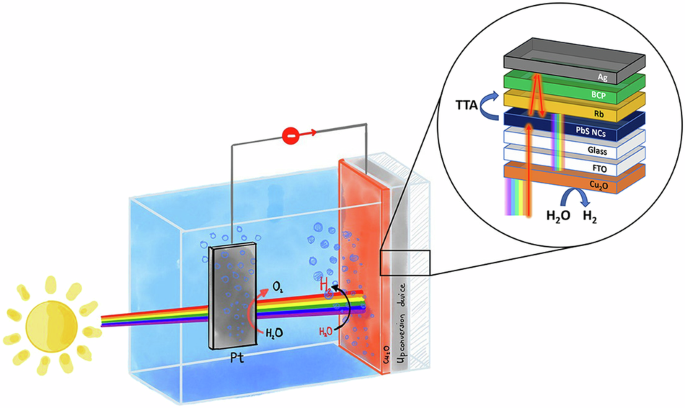Enhancing Solar Energy Harvesting for Hydrogen Production
Key Ideas
- Photoelectrochemical water-splitting cells are crucial for hydrogen production, with copper oxide semiconductors like cuprous oxide (Cu2O) showing promise due to their abundance and scalability.
- Efforts to improve the efficiency of solar energy utilization in photocatalysis involve enhancing light absorption, including harnessing infrared (IR) light through upconversion materials like triplet-triplet annihilation-based upconversion (TTA-UC).
- A novel device combining a Cu2O photocatalyst with an upconverter for IR light absorption has been developed, significantly enhancing light-harnessing properties through front and back-side illumination.
- The study explores the use of thin Au layers to improve the electronic junction and film quality of Cu2O on substrates, leading to enhanced photoelectrochemical and optical properties for solar-assisted water splitting.
Harnessing sunlight for hydrogen production through photoelectrochemical (PEC) water splitting is a promising approach in clean energy. Despite challenges in materials science, copper oxide semiconductors like cuprous oxide (Cu2O) offer scalability and abundance. Efforts to enhance solar energy utilization involve improving light absorption, particularly focusing on harnessing infrared (IR) light through upconversion materials like triplet-triplet annihilation-based upconversion (TTA-UC). By combining a Cu2O photocatalyst with an upconverter, a novel device has been developed to improve light-harnessing properties. The study also explores the use of thin Au layers to enhance the electronic junction and film quality of Cu2O on substrates, leading to improved photoelectrochemical and optical properties for solar-assisted water splitting.
Topics
Production
Materials Science
Energy Conversion
Solar Energy
Photocatalysis
Semiconductor Materials
Photoelectrochemical Cells
Upconversion Materials
Nanointerface Engineering
Latest News
